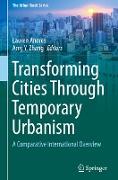Transforming Cities Through Temporary Urbanism
BücherAngebote / Angebote:
This book advances the reflexion into how temporary urbanism is shaping cities across the world. Temporary urbanism has become a core concept in urban development, and its application is increasingly crossing the borders of both the North and the Global South. There is a need to reflect upon the diverse ways of understanding and implementing the temporary in the production of space internationally and discuss what this means, for both research and practice. Divided into two sections, the book compiles and reflects upon the various attempts to reframe and reconceptualise temporary urbanism. The first section focuses on reframing and reconceptualising temporary urbanisms. It develops the argument that temporary urbanism allows a reinterrogation of the role of temporalities and non-permanence into the place-making process and hence in the production and reproduction of cities, including the adaptability of existing spaces and production of new spaces. While drawing upon different theoretical and conceptual framings (permeability, assemblage, rhythms, waiting, ...), authors bring insights from various case studies: the Dublin Biennial (Ireland), temporary uses in Geneva (Switzerland), temporary urban settlements in sub-Saharan Africa, refugees' camp in Beirut (Lebanon) and political protests in Skopje (Republic of Macedonia). The second section looks at unwrapping the complexity and diversity of temporary urbanisms. It aims at securing a better understanding of the complexity and diversity of temporary urbanism, including a dialogue between various experiences both in the Global North and in the Global South. It looks at the implications of temporary urbanism in the delivery of planning and considers how and by whom cities are governed and transformed. Again, a range of examples are mobilised by contributors spanning from temporary uses and projects in London (UK), Santiago (Chile), Paris (France), Vancouver (Canada), Barcelona (Spain), Budapest (Hungary), Beijing (China), Sao Paulo (Brazil) and Milwaukee (USA). This book will be of interests to all researchers, practitioners, and students who want to gain a more thorough understanding of the topic of temporary urbanism, compare its diversity and similarities across different contexts, and reflect on the wider implications of temporary urbanisms for urban transformations.
Folgt in ca. 15 Arbeitstagen



